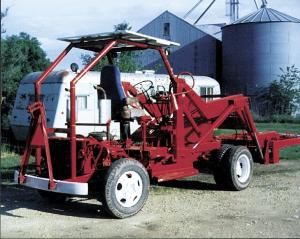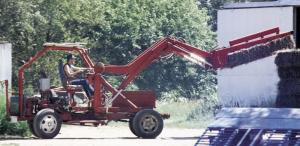Self-Propelled Small Square Bale Loader
Looking for a way to handle small square bales fast and efficiently for their custom baling business, Nate Regier, Newton, Kan., and his father Theodore built their own self-propelled small square bale loader out of an old 1 1/2-ton Ford truck chassis, a front-end loader, and a Farmhand 8-bale grabber.
"You won't find another one like it any-where," says Theodore. "It can reach out farther and higher than a tractor-mounted bale grabber and is equipped with an automatic transmission so it's easy to operate. It still has the truck's spring suspension system so we can go about 15 mph in the field. We pick up 8 bales at a time in the field. The bales are left in groups of 8 in the field by a Farmhand accumulator that's attached to our baler."
The Regiers bought the 1950 Ford truck at an auction for $125. They shortened the chassis 21 in., then flipped the rear end over to go backward so that the steering wheels are at the back and the dual drive wheels on front. The engine wasn't any good so it was replaced with a 350 cu. in. V-8 gas engine out of a Chevrolet car. The engine was then converted to propane. They left the Ford truck's original 4-speed transmission in and used a homemade coupler to connect it to the Chevrolet car's automatic transmission. A hydraulic pump that's belt-driven off the engine operates the rig's hydraulic cylinders. Two cylinders are used to raise the loader, two to tilt the bale fork, and one to open and close the hooks that grab the bales. The ma-chine has power steering (off the Chevy car), power brakes, a roll bar, shade canopy, lights, and the steering wheel off a Deere combine.
"We've used it for three years with no problems. We're amazed at how well it works," says Regier. "We use a hydraulic pump with an electric clutch that runs off the fan belt to activate the hydraulics. We can lift the bale fork 20 ft. high and stack bales 13 high - right to the top of our shed. We originally used the bale grabber and loader on front of an old Minneapolis Moline tractor, but bouncing across the field virtually destroyed the tractor's front end. On our new rig the weight is on the drive wheels so we can go faster without damaging anything.
"The 3-speed Chevy automatic transmission is connected to the 4-speed Ford trans-mission so altogether there are 12 forward and 3 reverse gears.. We could go 40 to 50 mph on the highway if we wanted. The gear-shift for the automatic transmission is on the steering column just like on a car so it's easy to shift gears. The rig doesn't even have a clutch - to shift to a higher range we stop and put the automatic transmission in neutral, then change gears on the truck transmission end loader, and a Farmhand 8 bale grabbe and put the auto transmission back in gear and go.
"We spent about $2,000 to build it, not including labor. A commercial model of comparable size would sell for about $20,000. Nate is a mechanic and was able to get the Chevy engine and transmission from his boss for only $50.
To transport it on the highway we tow it behind our gooseneck trailer. The manual transmission is taken out of gear to keep from damaging the automatic transmission."
Contact: FARM SHOW Followup, Theodore J. Regier, Bar Cedar Farm, 11675 N.W. 170th, Newton, Kan. 67114 (ph 316 799-2470).

Click here to download page story appeared in.
Click here to read entire issue
Self-Propelled Small Square Bale Loader BALE HANDLING Bale Handling (31B) 22-1-25 Looking for a way to handle small square bales fast and efficiently for their custom baling business, Nate Regier, Newton, Kan., and his father Theodore built their own self-propelled small square bale loader out of an old 1 1/2-ton Ford truck chassis, a front-end loader, and a Farmhand 8-bale grabber.
"You won't find another one like it any-where," says Theodore. "It can reach out farther and higher than a tractor-mounted bale grabber and is equipped with an automatic transmission so it's easy to operate. It still has the truck's spring suspension system so we can go about 15 mph in the field. We pick up 8 bales at a time in the field. The bales are left in groups of 8 in the field by a Farmhand accumulator that's attached to our baler."
The Regiers bought the 1950 Ford truck at an auction for $125. They shortened the chassis 21 in., then flipped the rear end over to go backward so that the steering wheels are at the back and the dual drive wheels on front. The engine wasn't any good so it was replaced with a 350 cu. in. V-8 gas engine out of a Chevrolet car. The engine was then converted to propane. They left the Ford truck's original 4-speed transmission in and used a homemade coupler to connect it to the Chevrolet car's automatic transmission. A hydraulic pump that's belt-driven off the engine operates the rig's hydraulic cylinders. Two cylinders are used to raise the loader, two to tilt the bale fork, and one to open and close the hooks that grab the bales. The ma-chine has power steering (off the Chevy car), power brakes, a roll bar, shade canopy, lights, and the steering wheel off a Deere combine.
"We've used it for three years with no problems. We're amazed at how well it works," says Regier. "We use a hydraulic pump with an electric clutch that runs off the fan belt to activate the hydraulics. We can lift the bale fork 20 ft. high and stack bales 13 high - right to the top of our shed. We originally used the bale grabber and loader on front of an old Minneapolis Moline tractor, but bouncing across the field virtually destroyed the tractor's front end. On our new rig the weight is on the drive wheels so we can go faster without damaging anything.
"The 3-speed Chevy automatic transmission is connected to the 4-speed Ford trans-mission so altogether there are 12 forward and 3 reverse gears.. We could go 40 to 50 mph on the highway if we wanted. The gear-shift for the automatic transmission is on the steering column just like on a car so it's easy to shift gears. The rig doesn't even have a clutch - to shift to a higher range we stop and put the automatic transmission in neutral, then change gears on the truck transmission end loader, and a Farmhand 8 bale grabbe and put the auto transmission back in gear and go.
"We spent about $2,000 to build it, not including labor. A commercial model of comparable size would sell for about $20,000. Nate is a mechanic and was able to get the Chevy engine and transmission from his boss for only $50.
To transport it on the highway we tow it behind our gooseneck trailer. The manual transmission is taken out of gear to keep from damaging the automatic transmission."
Contact: FARM SHOW Followup, Theodore J. Regier, Bar Cedar Farm, 11675 N.W. 170th, Newton, Kan. 67114 (ph 316 799-2470).
To read the rest of this story, download this issue below or click
here to register with your account number.








